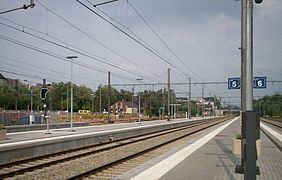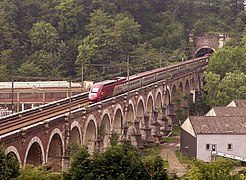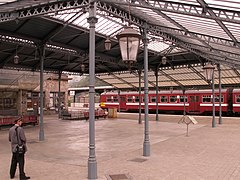Railway line Liège – Aachen
| Liège – Aachen | |||||||||||||||||||||||||||||||||||||||||||||||||||||||||||||||||||||||||||||||||||||||||||||||||||||||||||||||||||||||||||||||||||||||||||||||||||||||||||||||||||||||||||||||||||||||||||||||||||||||||||||||||||||||||||||||||||||||||||||||||||||||||||||||||||||||||||||||||||||||||||||||||||||||||||||||||||||||||||||||||||||||||||||||||||||||||||||||||||||||||||||||||
|---|---|---|---|---|---|---|---|---|---|---|---|---|---|---|---|---|---|---|---|---|---|---|---|---|---|---|---|---|---|---|---|---|---|---|---|---|---|---|---|---|---|---|---|---|---|---|---|---|---|---|---|---|---|---|---|---|---|---|---|---|---|---|---|---|---|---|---|---|---|---|---|---|---|---|---|---|---|---|---|---|---|---|---|---|---|---|---|---|---|---|---|---|---|---|---|---|---|---|---|---|---|---|---|---|---|---|---|---|---|---|---|---|---|---|---|---|---|---|---|---|---|---|---|---|---|---|---|---|---|---|---|---|---|---|---|---|---|---|---|---|---|---|---|---|---|---|---|---|---|---|---|---|---|---|---|---|---|---|---|---|---|---|---|---|---|---|---|---|---|---|---|---|---|---|---|---|---|---|---|---|---|---|---|---|---|---|---|---|---|---|---|---|---|---|---|---|---|---|---|---|---|---|---|---|---|---|---|---|---|---|---|---|---|---|---|---|---|---|---|---|---|---|---|---|---|---|---|---|---|---|---|---|---|---|---|---|---|---|---|---|---|---|---|---|---|---|---|---|---|---|---|---|---|---|---|---|---|---|---|---|---|---|---|---|---|---|---|---|---|---|---|---|---|---|---|---|---|---|---|---|---|---|---|---|---|---|---|---|---|---|---|---|---|---|---|---|---|---|---|---|---|---|---|---|---|---|---|---|---|---|---|---|---|---|---|---|---|---|---|---|---|---|---|---|---|---|---|---|---|---|---|---|---|---|---|---|---|---|---|---|---|---|---|---|---|---|---|---|---|---|---|---|---|---|---|---|---|---|---|---|---|---|---|---|---|---|---|---|---|
|
Belgian route L37 from Liège to the German border near Aachen
| |||||||||||||||||||||||||||||||||||||||||||||||||||||||||||||||||||||||||||||||||||||||||||||||||||||||||||||||||||||||||||||||||||||||||||||||||||||||||||||||||||||||||||||||||||||||||||||||||||||||||||||||||||||||||||||||||||||||||||||||||||||||||||||||||||||||||||||||||||||||||||||||||||||||||||||||||||||||||||||||||||||||||||||||||||||||||||||||||||||||||||||||||
| Route number (DB) : | 2600 | ||||||||||||||||||||||||||||||||||||||||||||||||||||||||||||||||||||||||||||||||||||||||||||||||||||||||||||||||||||||||||||||||||||||||||||||||||||||||||||||||||||||||||||||||||||||||||||||||||||||||||||||||||||||||||||||||||||||||||||||||||||||||||||||||||||||||||||||||||||||||||||||||||||||||||||||||||||||||||||||||||||||||||||||||||||||||||||||||||||||||||||||||
| Route number : | L 37 (Belgium) | ||||||||||||||||||||||||||||||||||||||||||||||||||||||||||||||||||||||||||||||||||||||||||||||||||||||||||||||||||||||||||||||||||||||||||||||||||||||||||||||||||||||||||||||||||||||||||||||||||||||||||||||||||||||||||||||||||||||||||||||||||||||||||||||||||||||||||||||||||||||||||||||||||||||||||||||||||||||||||||||||||||||||||||||||||||||||||||||||||||||||||||||||
| Course book section (DB) : | 480a | ||||||||||||||||||||||||||||||||||||||||||||||||||||||||||||||||||||||||||||||||||||||||||||||||||||||||||||||||||||||||||||||||||||||||||||||||||||||||||||||||||||||||||||||||||||||||||||||||||||||||||||||||||||||||||||||||||||||||||||||||||||||||||||||||||||||||||||||||||||||||||||||||||||||||||||||||||||||||||||||||||||||||||||||||||||||||||||||||||||||||||||||||
| Route length: | 53.8 km | ||||||||||||||||||||||||||||||||||||||||||||||||||||||||||||||||||||||||||||||||||||||||||||||||||||||||||||||||||||||||||||||||||||||||||||||||||||||||||||||||||||||||||||||||||||||||||||||||||||||||||||||||||||||||||||||||||||||||||||||||||||||||||||||||||||||||||||||||||||||||||||||||||||||||||||||||||||||||||||||||||||||||||||||||||||||||||||||||||||||||||||||||
| Gauge : | 1435 mm ( standard gauge ) | ||||||||||||||||||||||||||||||||||||||||||||||||||||||||||||||||||||||||||||||||||||||||||||||||||||||||||||||||||||||||||||||||||||||||||||||||||||||||||||||||||||||||||||||||||||||||||||||||||||||||||||||||||||||||||||||||||||||||||||||||||||||||||||||||||||||||||||||||||||||||||||||||||||||||||||||||||||||||||||||||||||||||||||||||||||||||||||||||||||||||||||||||
| Route class : | D4 | ||||||||||||||||||||||||||||||||||||||||||||||||||||||||||||||||||||||||||||||||||||||||||||||||||||||||||||||||||||||||||||||||||||||||||||||||||||||||||||||||||||||||||||||||||||||||||||||||||||||||||||||||||||||||||||||||||||||||||||||||||||||||||||||||||||||||||||||||||||||||||||||||||||||||||||||||||||||||||||||||||||||||||||||||||||||||||||||||||||||||||||||||
| Power system : | 3 kV = | ||||||||||||||||||||||||||||||||||||||||||||||||||||||||||||||||||||||||||||||||||||||||||||||||||||||||||||||||||||||||||||||||||||||||||||||||||||||||||||||||||||||||||||||||||||||||||||||||||||||||||||||||||||||||||||||||||||||||||||||||||||||||||||||||||||||||||||||||||||||||||||||||||||||||||||||||||||||||||||||||||||||||||||||||||||||||||||||||||||||||||||||||
| Maximum slope : | 26 ‰ | ||||||||||||||||||||||||||||||||||||||||||||||||||||||||||||||||||||||||||||||||||||||||||||||||||||||||||||||||||||||||||||||||||||||||||||||||||||||||||||||||||||||||||||||||||||||||||||||||||||||||||||||||||||||||||||||||||||||||||||||||||||||||||||||||||||||||||||||||||||||||||||||||||||||||||||||||||||||||||||||||||||||||||||||||||||||||||||||||||||||||||||||||
| Top speed: | 140 km / h | ||||||||||||||||||||||||||||||||||||||||||||||||||||||||||||||||||||||||||||||||||||||||||||||||||||||||||||||||||||||||||||||||||||||||||||||||||||||||||||||||||||||||||||||||||||||||||||||||||||||||||||||||||||||||||||||||||||||||||||||||||||||||||||||||||||||||||||||||||||||||||||||||||||||||||||||||||||||||||||||||||||||||||||||||||||||||||||||||||||||||||||||||
| Dual track : | (continuous) | ||||||||||||||||||||||||||||||||||||||||||||||||||||||||||||||||||||||||||||||||||||||||||||||||||||||||||||||||||||||||||||||||||||||||||||||||||||||||||||||||||||||||||||||||||||||||||||||||||||||||||||||||||||||||||||||||||||||||||||||||||||||||||||||||||||||||||||||||||||||||||||||||||||||||||||||||||||||||||||||||||||||||||||||||||||||||||||||||||||||||||||||||
|
|||||||||||||||||||||||||||||||||||||||||||||||||||||||||||||||||||||||||||||||||||||||||||||||||||||||||||||||||||||||||||||||||||||||||||||||||||||||||||||||||||||||||||||||||||||||||||||||||||||||||||||||||||||||||||||||||||||||||||||||||||||||||||||||||||||||||||||||||||||||||||||||||||||||||||||||||||||||||||||||||||||||||||||||||||||||||||||||||||||||||||||||||
The Liège – Aachen line is a 54-kilometer, double-track , electrified main line of international rail traffic between Belgium and Germany , which opened on October 15, 1843 and connects Liège with Verviers and Aachen . Within Belgium, it runs in sections in the valley of the Weser (French: Vesdre), a tributary of the Ourthe , and is therefore sometimes referred to as the Weser valley route .
In the inner Belgian region, it mainly serves to develop large parts of East Belgium , the industrial area around Verviers and the capital of the German-speaking community , Eupen .
With its sections from Liège-Guillemins to Chênée and from the Hammerbrücke junction near Hauset to Aachen, it is part of the high-speed line Paris – Brussels – Cologne . From Chênée to Hauset, the high-speed line HSL 3, which runs essentially parallel but outside the valley of the Weser, is used for high-speed traffic .
Route description
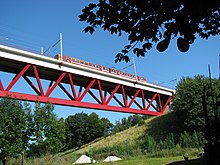
In the Dolhain – Angleur section, the route crosses the Weser valley, a scenic side valley in the Ardennes . The Verviers agglomeration area traversed by the connection is densely populated and industrialized.
The railway line is characterized by many tunnels, such as the Buschtunnel and numerous Weser crossings. The most famous of these bridges is the Dolhain Viaduct . Another well-known engineering structure is the Hammerbrücke over the Göhl valley near Hergenrath , where a 209 meter long and up to 40 meter high masonry viaduct with a double row of arches stood in its place until 1940, which, like the viaduct of Moresnet, was also known as the Geultal viaduct . There is also a 4.3 kilometer long ramp between Liège and Ans that overcomes a difference in altitude of 110 meters.
The Liège fortress ring is crossed twice. For this reason, the route was secured in various places with bunkers , the remains of which can still be seen today.
Important nodes
The route has its starting point in Aachen Central Station , built in 1901 , from where the main routes to Mönchengladbach / Düsseldorf and Cologne also begin. The Euregiobahn also runs from there to Stolberg-Altstadt / Weisweiler and Alsdorf.
The former Herbesthal border station was closed in 1966, and today's border station in Welkenraedt, just a kilometer further to the west, took over . There are extensive shunting and storage facilities for the P-trains to Brussels used during rush hour, as well as the Ostend – Eupen intercity trains, as the Eupen station on the Welkenraedt – Raeren railway line does not have a storage facility . In Welkenraedt there was also an electrified feeder line to the Montzen route to Antwerp , which was only used for goods traffic and some internal passenger transports.
The next major train station is Verviers Central Station , Verviers Central . As a special feature, this five-track station is designed as a saddle station, which means that the station building, which was built across the tracks, is saddled on top of it . The station was built in the 1930s and has since replaced the former Verviers-Ouest terminus, which served as the main station .
Behind the Verviers train station, in the wedge station Pepinster, the route branches off into the branches to Liège and Spa. Between the platforms of the respective directions (Liège, Aachen, Spa) there is an interesting and lavishly restored station hall , which ensures that you can change trains between trains on dry feet. The route ends at Liège-Guillemins station , from where there are connections to Hasselt / Antwerp, Maastricht, Luxembourg, Namur and Brussels.
- Line Liège – Aachen
Operation and history
The construction of the line and the previous approval of February 12, 1837 were the result of lengthy negotiations between the Rheinische Eisenbahngesellschaft and a committee of high-ranking Aachen personalities, including the President of the Aachen Chamber of Commerce , David Hansemann , and the Aachen District President Adolf Heinrich Graf von Arnim-Boitzenburg and the cloth and needle manufacturer Philipp Heinrich Pastor .
The representatives of Aachen had campaigned for the route to run via Aachen ( Rheinischer Bahnhof ) and the Weser Valley to Liège, contrary to the originally planned extensive bypassing of Aachen . However, this also necessitated the construction of the so-called Ronheider ramp , an inclined plane that could initially only be overcome by means of a cable-operated operation with a stationary steam engine, and the construction of the bush tunnel, both in the area of the city forest between the city center and the German-Belgian border. The line, which has been under construction since 1838, was opened on October 15, 1843. It is the world's first cross-border railway line.
In the 1930s, a thorough restructuring of the railways took place in Verviers, than the previous railhead Verviers-Ouest by the new transit station Verviers Central was replaced. The fastest train on the route at that time was the Ostend-Cologne-Pullman Express , which provided a fast daily connection between Cologne and London.
The Second World War brought about the destruction of the Hammerbrücke near Hergenrath, a two-storey brick arch bridge . The viaduct was not rebuilt in the old geometry. In the post-war period, steel trusses were instead mounted on the old pillars. The temporary solution was finally replaced in 1997 by a completely new building.
In the course of the increasing importance of the line in international traffic, it was electrified in 1966, whereby the entire line is operated with 3 kilovolt DC voltage in Germany as well. The switch between the traction current systems of Germany and Belgium takes place in Aachen Central Station. For this purpose, the overhead lines on tracks 6 to 9 are equipped so that either the 15 kilovolt 16.7 Hertz alternating voltage of the Deutsche Bundesbahn or the 3 kilovolt direct voltage of the NMBS / SNCB can be switched on.
While the SNCB closed numerous less frequented stops in the 1980s, a renaissance of rail traffic took place on the branching line Welkenraedt – Eupen :
The branch line on which passenger traffic had already been discontinued in the post-war period was reactivated and electrified in 1984 under political pressure from the German-speaking Community (DG), and the newly built Eupen station (capital of the DG) became the end point of the InterCity line Ostend-Brussels –Liege – Verviers – Eupen. This line is the most important east-west rail link in Belgium.
The section Aachen Hauptbahnhof - Aachen Süd (border) was expanded for 160 km / h. For this purpose, the bush tunnel near the border with Belgium received a second tunnel tube, which was built between 2004 and 2007. The old tube was then modernized and opened again on October 23, 2011. Since then, only one track has run in both tubes, so that a single-track tube is available in each direction to handle the expected additional traffic on the Cologne - Brussels - Paris axis and to London.
In the course of the privatization of NMBS / SNCB, the section of the line in Belgium has been maintained by Infrabel since 2005 .
In October 2013, extensive tunneling work began at Verviers Central station . The tunnel ceiling under the bus yard is to be raised by 40 centimeters so that double-decker cars can also be used after the work has been completed. It is estimated to cost two million euros, the expected construction time will last until the end of 2017.
The traffic, which has always been characterized by traditional express trains such as the Ostend-Wien-Express , the Nord-Express or the Tauern-Express , underwent the next fundamental change in the 1990s:
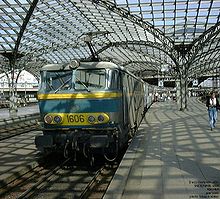
The Thalys high-speed train has been running the route for the first time since 1997, and from 2002 the last remaining continuous D / IC train connections from Cologne via Brussels to Ostend on the Frankfurt am Main – Cologne – Brussels section were replaced by Intercity Express trains. The journey from Cologne to Ostend today requires a train change once or twice and has not been able to continue to Great Britain since 2013 after the operator of the only ferry connection from Ostend to Ramsgate went bankrupt. The summer timetable 2009, these high-speed trains leaving the track in the immediate Wesertal and since then over the newly built HSL-3 - high-speed line out.
The D-trains Cologne – Ostend were replaced in 2002 by the Interregio q euregioAIXpress as a new cross-border train in local rail passenger transport . The trains ran every two hours between Aachen and Liège-Guillemins from December 2002 to December 2014. Since December 2014, the train has been running as the L 09 regional line from Aachen to Spa-Géronstère. Since then there are no longer any direct public transport connections to Liège-Guillemins . The trains are run as Regional Express 29 in Aachen Central Station . The name, the play on words euregioAIXpress , is made up of the words Euregio , Aix-la-Chapelle (French name of Aachen ) and Express . On September 3, 2018, Chaudfontaine station was reopened and the L 17 became the S 41 as part of the introduction of the Liège S-Bahn .
Current operation
The route is currently served hourly in the Welkenraedt – Liège section by Belgian IC trains (line 01) from Eupen to Oostende, which are made up of a locomotive from the NMBS / SNCB series 18 and twelve I11 cars or M6 cars . In December 2014, an additional IC line (line 12, Mon-Fri) consisting of M6 cars was introduced between Welkenraedt and Kortrijk via Liège and Brussels, so that InterCity trains run every half hour on the Welkenraedt-Liège section. Since January 20, 2020 an international night train has been running again from Brussels via Liège and Aachen to Vienna / Innsbruck, this runs twice a week and is offered by ÖBB as a NightJet, so there is again an offer that was already there until December 2003 gave.
In addition to the InterCity connections, two local transport lines have been running on the route since the timetable change in December 2014:
- the euregioAIXpress Aachen – Welkenraedt – Verviers – Pepinster – Spa-Géronstère
- the local train (S 41) Verviers Central – Liège – Herstal.
Both lines are used every hour. This local rail passenger transport is carried out by the SNCB , which uses electric multiple units of the NMBS / SNCB series AM 62-79 for the L train service .
| line | Line designation | Line course |
|---|---|---|
| IC 01 | InterCity | Ostend - Brussels - Liège - Verviers - Eupen |
| IC 12 | InterCity | Kortrijk - Ghent - Brussels - Liège - Verviers - Welkenraedt |
| L 09 RE 29 | EuregioAIXpress | Spa-Géronstère - Verviers - Welkenraedt - Aachen |
| P 41 | Train | Herstal - Liège - Verviers Central |
| P | Amplifier train | Welkenraedt - Verviers - Liège - Herstal |
literature
- The Rhenish-Belgian Railway . In: Illustrirte Zeitung . No. 24 . J. J. Weber, Leipzig December 9, 1843, p. 375 ( books.google.de ).
- Trains magazine , 1/2007
Web links
Individual evidence
- ↑ DB Netze - Infrastructure Register
- ↑ Railway Atlas Germany . 9th edition. Schweers + Wall, Aachen 2014, ISBN 978-3-89494-145-1 .
- ^ Paul G. Land: The construction of the Cologne – Aachen – Antwerp line. The Prussian section . Marcel Lambou: The international rail link Liège – Cologne . In: Die Deutsche Bahn , 9-10 / 1993
- ↑ Extension line (ABS) 4. Cologne - Düren - Aachen - Paris / Amsterdam: 1st construction phase Cologne - Düren . Sixteen-page brochure, August 2002.
- ↑ Chantal Delhez: Verviers station is being completely renovated. In: BRF. Belgian Broadcasting, October 7, 2013, accessed October 12, 2013 .
- ^ BRF News of September 22, 2015
- ↑ Rehaussement du tunnel de la 'Chic-Chac' à Verviers , press release from infrabel.be (French)
- ↑ ksta.de ( Memento of the original from June 16, 2009 in the Internet Archive ) Info: The archive link was inserted automatically and has not yet been checked. Please check the original and archive link according to the instructions and then remove this notice.



